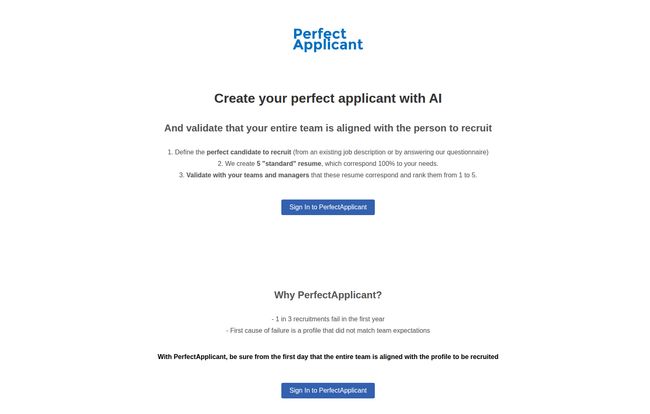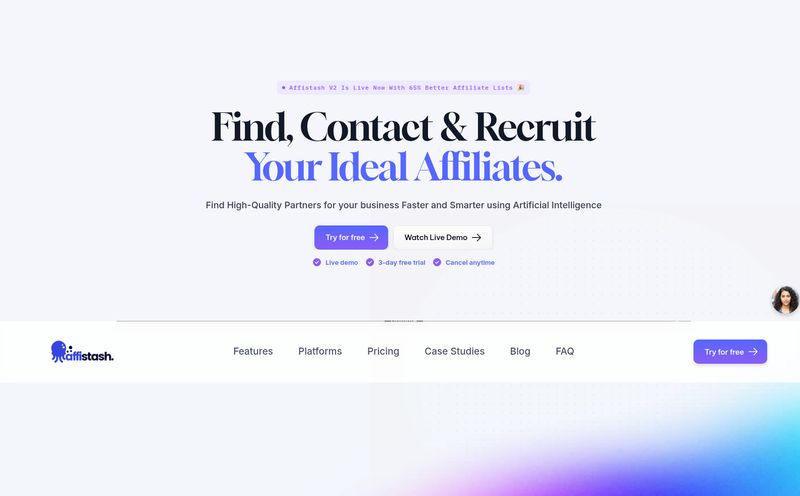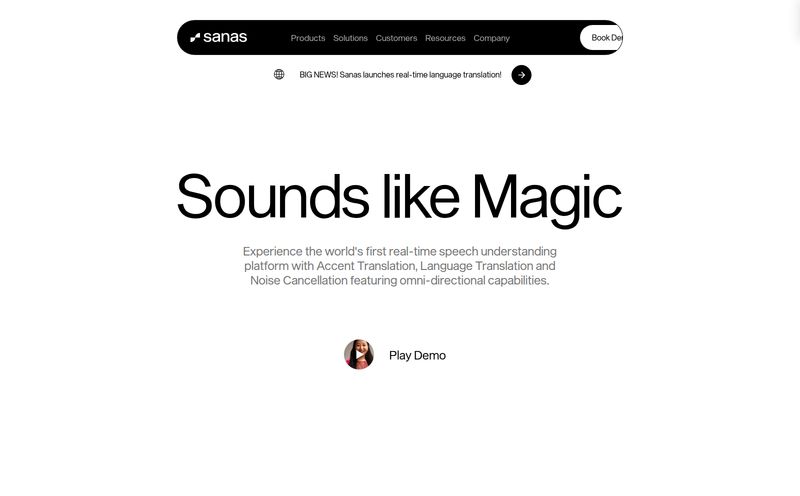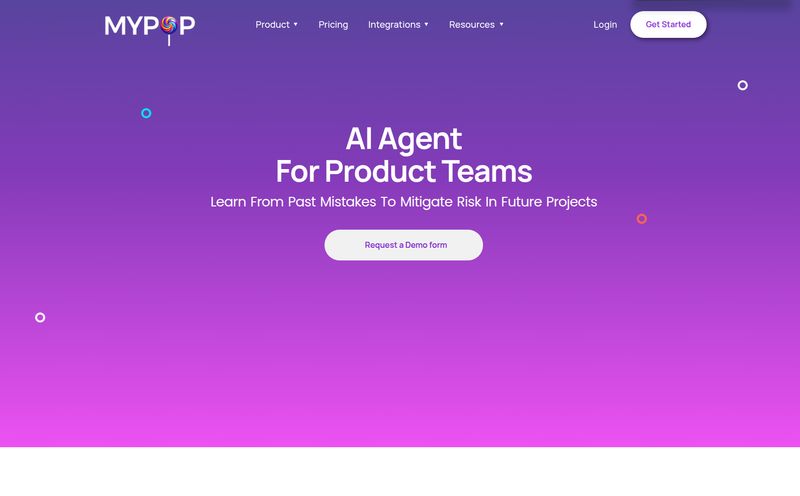We’ve all been there. You spend weeks, sometimes months, crafting the perfect job description, sifting through mountains of resumes, and conducting countless interviews. You finally find the one. The candidate with the killer resume, the great interview rapport, the right experience. The team signs off, an offer is made, and everyone celebrates.
Then, three months later... it’s just not working out. The new hire is technically skilled, sure, but they’re not what the department manager actually needed. The Head of Product thought they were hiring a data-crunching analyst, while the direct manager was expecting a client-facing strategist. It’s a classic case of lost in translation. A costly, frustrating, and morale-killing case.
This misalignment is the silent killer of so many promising hires. It’s a problem I’ve seen plague startups and established companies alike. So when I stumbled upon a tool called PerfectApplicant, which claims to tackle this exact problem head-on, my curiosity was definitely piqued. It’s not another sourcing platform or ATS. Its goal is much simpler, and maybe, just maybe, more profound: to make sure everyone on your hiring team is actually on the same page before you even look at the first real candidate.
What is PerfectApplicant, Really?
Think of PerfectApplicant as a pre-flight checklist for your recruitment process. Before you fire up the engines and start spending money on job board listings and LinkedIn outreach, it forces you to sit down with your co-pilots (the hiring manager, the department head, etc.) and agree on the destination. It’s an AI-powered platform designed for one thing: team alignment.
It doesn’t find candidates for you. Instead, you feed it your job description or fill out a questionnaire, and its AI generates five “standard” resumes. These aren’t real people. They’re fictional profiles, perfectly tailored to the requirements you provided. Your team then independently reviews and ranks these five fictional applicants. The magic happens when you compare the results. Did everyone rank the same profile as number one? Or is the team’s preference all over the map? Suddenly, your hidden misalignments are brought out into the open.
The Vicious Cycle of Hiring Misalignment
The site for PerfectApplicant throws a stat at you: 1 in 3 recruitments fail in the first year because the profile didn’t match team expectations. Oof. That feels painfully accurate from my years in this game. The cost of a bad hire isn't just the salary paid; according to the U.S. Department of Labor, it can be up to 30% of the employee's first-year earnings. For a senior role, that's a devastating financial hit.
But the numbers dont tell the whole story. A bad hire drains team energy, ruins project momentum, and forces you to start the entire, exhausting hiring process all over again. It’s a vicious cycle, and the root cause is almost always a failure to properly define and agree upon what “good” looks like for a specific role.
How PerfectApplicant Tries to Break the Cycle
The process is refreshingly simple, which in a world of overly complex SaaS tools, is a breath of fresh air. It boils down to three core steps.
Step 1: Defining Your North Star Candidate
It all starts with your input. You can either upload an existing job description or answer a guided questionnaire. This is the foundational data the AI will use. And here lies the first major dependency: the quality of your input dictates the quality of the output. Garbage in, garbage out, as they say.
Step 2: The AI Creates Your Fictional Applicants
This is where the AI does its thing. It generates five distinct, yet plausible, resumes that all theoretically fit the job description. Maybe one leans more heavily on technical skills, another on management experience, and a third on a non-traditional background with amazing project outcomes. They are, in essence, different interpretations of your job description.
Step 3: The Moment of Truth—Team Validation
Each member of the hiring committee gets a link to review and rank the five “standard” resumes from 1 to 5. This is the core of the tool’s value proposition. It’s a blind test. When the results are in, you get a clear, data-driven picture of your team’s alignment—or lack thereof. If everyone chose Candidate #3 as their top pick, congratulations! You’re aligned. But if your Head of Engineering loves Candidate #1 and the Product Manager insists on Candidate #4, you’ve just uncovered a critical misalignment that would have caused chaos down the line. Now you can have the right conversation, using these concrete profiles as a guide.

Visit PerfectApplicant
My Honest Take on The Good and The Bad
No tool is perfect, despite the name. After digging into how it works, here’s my breakdown of where I think PerfectApplicant shines and where it might stumble.
What I Like About It
I genuinely believe this tool solves a real, and often ignored, problem. Forcing a structured conversation about the ideal candidate before the search begins is just smart. It turns subjective feelings into a tangible ranking exercise. This can save dozens of wasted hours and prevent that sinking feeling of a hire-gone-wrong. It’s preventative medicine for your hiring process, rather than emergency surgery later on.
Where It Might Stumble
The main weakness is its dependency on that initial job description. If the JD is vague or poorly written, the AI-generated profiles will reflect that. Secondly, it can't fully capture the nuanced, human elements of a role. Things like culture fit, soft skills, and a candidate's potential growth trajectory are hard to bake into a resume, real or fake. Finally, the limit of five generated resumes feels a bit arbitrary. Sometimes the ideal profile might be a blend of two of them, and it doesn't seem to account for that.
Who Is This Tool Actually For?
I don't see this being a must-have for a solo recruiter hiring for highly standardized roles. But for a growing startup, a mid-sized company creating a new department, or any organization hiring for a complex, cross-functional role? I think it could be incredibly valuable. It’s for teams where the hiring manager, a department head, and maybe even the CEO all have a stake—and a slightly different vision—in who to bring on board. It helps translate those different visions into a single, unified language.
What About The Cost?
Here’s a bit of a head-scratcher. As of my review, there’s no public pricing page. The link in some of their materials seems to be broken, leading to a 'Not Found' error. This could mean a few things. They might be in an early-stage beta, operating on a custom-quote basis for teams, or perhaps they're in the middle of updating their model. For now, the only way to find out is to sign in and engage with them directly. A bit of a mystery, but not a deal-breaker if the tool genuinely solves a costly problem for you.
Final Thoughts: A Calibrator, Not a Crystal Ball
I’m walking away from my analysis of PerfectApplicant feeling cautiously optimistic. It’s not a magic wand that will find you the perfect employee. It’s a compass. It’s a calibration tool designed to ensure everyone on the hiring team is pointing in the same direction before you take the first step. It won’t replace the human element of recruiting—the intuition, the conversation, the gut feeling. But it provides a solid, data-informed foundation to build upon. And in a world of bad hires and misaligned expectations, that's a pretty valuable thing to have.
By front-loading the difficult conversations, it might just save you from having a much more difficult one six months down the road. And for any hiring manager, that’s a promise worth looking into.
Frequently Asked Questions about PerfectApplicant
Is PerfectApplicant a recruitment or sourcing tool?
No, it's not. PerfectApplicant is a pre-recruitment alignment tool. It doesn't find or manage real candidates. It's used internally by your team to ensure everyone agrees on the ideal candidate profile before you start the actual search.
How does the AI generate the “standard” resumes?
The AI uses the job description you provide or the answers from its questionnaire to generate five distinct, fictional candidate profiles. Each resume is a different, plausible interpretation of your requirements, designed to test your team's priorities.
Can PerfectApplicant guarantee a perfect hire?
No tool can guarantee a perfect hire. Human dynamics are too complex. However, it significantly improves your chances of success by addressing one of the biggest reasons for failure: internal team misalignment on what the role requires.
What happens if my team can't agree on the rankings?
That's actually the point! If your team's rankings are all over the place, the tool has successfully done its job by exposing a critical misalignment. This is your cue to have a focused discussion, using the ranked resumes as conversation starters to get everyone on the same page.
Is PerfectApplicant free to use?
Currently, their pricing is not publicly listed on their website. This suggests they may be operating on a demo or custom-quote basis for interested teams. The best approach is to sign up or contact them directly for information.
Is this better than just having a team meeting?
While a team meeting is good, PerfectApplicant provides a structured framework that can make that meeting much more productive. Instead of relying on abstract descriptions, your team reacts to concrete (though fictional) resumes. This often reveals biases and assumptions that wouldn't surface in a simple conversation.
Reference and Sources
- PerfectApplicant Official Website
- SHRM - The Real Costs of Recruitment (for general context on hiring costs)



